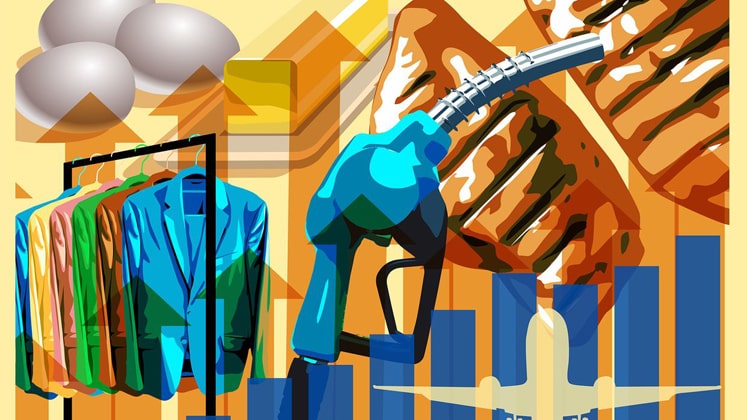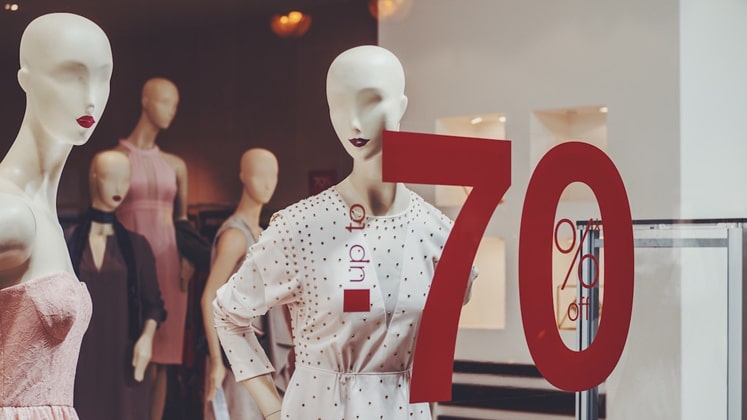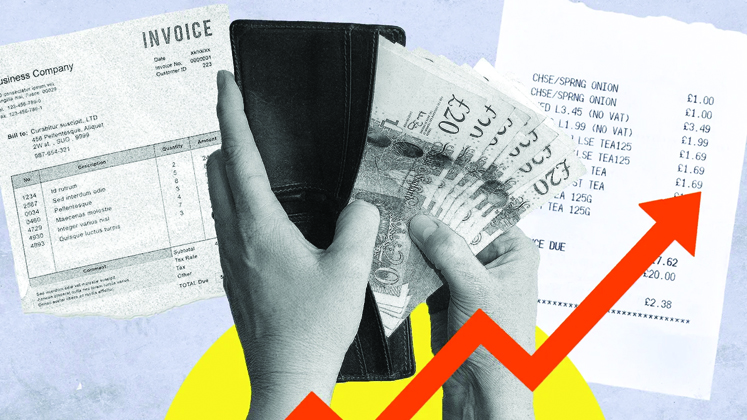In the US, inflation has risen by 8.3 per cent since last August, while in the UK, it has risen to 9.9 per cent since the same period in 2021.
According to The Economic Times, online sales are expected to account for US $ 95 billion less in 2022 compared to last year – a wake-up call for e-commerce businesses.
The British high street is struggling to cope with increasing pressures brought forth by the cost-of-living crisis. Research from curated marketplace Ankorstore’s first Summer Retail Trend Report, supported by British Retail Champion Mary Portas, reveals that 74 per cent of retailers believe that the cost-of-living crisis and current inflation hitting a 40-year high at 10.1 per cent will be almost twice as damaging to the UK’s high street than the Covid-19 pandemic.
Retailers also added that higher rents (71 per cent), increased online shopping (70 per cent) and rising parking costs (38 per cent), are all impacting their abilities to operate, which is thus causing the UK high street to decline.
With the holiday season coming up, four out of ten households are worried about affording Christmas, pointing towards a trend that promotes researching for the best value deals to take precedence this holiday season.
Despite the cost of living crisis, continued economic turbulence and geo-political instability in 2022, ESW’s Global Voices: Consumer Pulse 2022 survey of more than 14,000 consumers across fourteen countries, found that a fifth of consumers (21 per cent) purchased luxury goods internationally, driven by shoppers in China (46 per cent), South Korea (36 per cent) and UAE (34 per cent).
However, Ankorstore reveals there is optimism for the future of British retail, as over two-thirds of retailers (69 per cent) believe that all consumers are keen to shop locally, as the local shopping trend continues to gain momentum.
“Community is at the heart of British high streets – and right now they are facing challenges from all angles. It’s vital that we together create resilient and revitalised high streets that meet people’s needs. It’s not just about doing business – it’s about doing business in the right way and championing real change for new and independent retailers,” Mary Portas said in a statement.
There is also an indication that retailers are gradually seeing life slowly return to towns and cities following the pandemic, with 98 per cent of those operating online agreeing that British high streets are struggling, compared to only 86 per cent of retailers who run a physical store.
In this report, we highlight the various factors being brought forth due to the cost of living crisis and how brands and retailers can navigate through this turbulent and uncertain time in order to ensure stability and sales.
Discounted marketplaces win the race
With the skyrocketing costs of living, both fashion and retail businesses, particularly with customers shopping for bargain prices and goods on sale, are being impacted in a big way while paving the way for the future.
Luxury players have reported their gross margins remaining under significant pressure with customer appetite weighted towards markdowns amidst a heavily promotional environment, whilst discount marketplaces are seeing their sales soar.
Claiming a combined market share of 16 percent as shoppers continue to look for ways to keep costs down amid soaring inflation and rising grocery prices, discounted deals are emerging as a sureshot way to win customer attention as well as secure their confidence.
Moreover, customers are choosing own label brands over established names, not just in grocery but also in fashion. Store’s own brands, or private labels, typically offer price points that are the openers in a specific category and therefore more accessible.
Office for National Statistics (ONS) reported that real basic wages are falling at their fastest rate on record, with the public sector being worst hit. This essentially means the high cost of living will continue to squeeze households and therefore retailers alike for some time to come.
Consumers place precedence on shopping locally and purchasing unique products they can’t buy online
Retailers and brands that are looking to boost foot traffic and increase sales, should position monitoring and responding to consumer trends at the top of their agenda.
Ankorstore’s report highlights that today’s shoppers are increasingly looking to shop for unique products they can’t buy online (71 per cent), along with sustainable products (62 per cent) and location-centric products that support the local area (47 per cent).
The report also highlights that retailers are seeing cost (79 per cent), product quality (68 per cent) and sustainability (43 per cent) informing consumer purchases as British consumers look to buy better and more affordable products.
“Our mission at Ankorstore is to help level the playing field for local and independent retailers, who are facing immense external pressures. A huge part of this involves giving retailers the confidence, tools and purchasing conditions they need to thrive on British high streets,” Tarun Gidoomal, UK General Manager at Ankorstore, said in a release.
“Times are tough right now, but post-pandemic shopping habits show that consumers want to shop local. That’s why we are helping to connect independent brands with local retailers.”
Impact on holiday season turnover
While it is too soon to say what will or will not work for brands and retailers to optimise their Christmas turnover, one thing is for certain – that they need to form a connection with their audience and have integrity at the heart of their brand messaging and campaigns.
“Brands that emphasise their marketing investments on searchable content that demonstrates consumer value will prevail,” Jacquelyn Baker, Chief Commerce Experience Officer at VMLY&R Commerce, told The Drum. She added, “Inflation concerns are very real,” and then went on to say, “currency has to stretch much further than it used to and that will continue into the next two years.”
A good example for retailers and brands is to look at data from the financial crisis of 2008-2010, where shoppers abstained from big ticket items and instead gravitated towards small, affordable luxuries, like fragrances and accessories.
This year’s holiday shopping season is expected to be more like 2021, where increased product prices, high shipping fees and supply chain woes will affect consumer spending and the bottom line.
Retailers and brands should look at data from the financial crisis of 2008-2010, where shoppers abstained from big ticket items and instead gravitated towards small, affordable luxuries.
According to Salesforce, the demand for online shopping is levelling off, with consumers finding a new balance between digital and physical channels.
Many shoppers are expected to make purchases early in the run-up to Christmas, to avoid pricing hikes and potential product shortages. Others will be waiting for the discounting season to begin, which this year could be the silver lining for consumers on a tight budget, as retailers struggle to offload inventory. Consumers will be waiting for the very best deals and Black Friday and Amazon Prime day could be big bonanza periods for brands.
Key predictions for the peak season by Salesforce include transparency and sustainability, with inflation data showing how it will affect holiday shopping. Brands should be honest about their carbon footprint and offer sustainable packaging and shipping options.
The cost of living crisis will extend well into 2023 and it will be a challenging journey for retailers leading into the Christmas period as the high street faces a decrease in shoppers, footfall and sales.
Cross-border luxury sales continue to soar despite economic turbulence
With sales up by 17 per cent in the first six months of 2022, according to research from global and domestic direct-to-consumer (DTC) e-commerce company ESW, cross-border online sales of luxury goods continue to increase, despite diminishing consumer confidence.
The most popular luxury product categories that have been shopped cross-border are handbags and accessories (amounting to 44 per cent), followed by clothing (amounting to 42 per cent) and jewellery (at 39 per cent).
With sales up by 17 per cent in the first six months of 2022, cross-border online sales of luxury goods continue to increase, despite diminishing consumer confidence.
In addition to this, global international sales of handbags and accessories and jewellery were higher than those in domestic markets (40 per cent and 33 per cent, respectively). Shoppers cited satisfaction with previous cross-border purchases (31 per cent) and a lack of availability in their home markets (27 per cent) as being the key drivers behind their decision to purchase from international luxury brands.
That being said, the UK has ranked as the second most popular market for cross-border purchasing of luxury goods (at 32 per cent), second only to the US (which sits at 56 per cent) and ahead of the traditional luxury markets of France (29 per cent) and Italy (25 per cent).
British luxury products were purchased most frequently from shoppers in the UAE and China (both 40 per cent), India (39 per cent) and Japan (38 per cent).
“Luxury continues its ascent as cross-borders’ best performing category with this latest reported increase of +16 percent which is even more impressive, considering our research shows sales in this category grew by 50 percent in 2021,” Natashia Redfern, Vice President UK Country Sales Director at ESW, said in a statement.
“This showcases the impressive work luxury retailers have put in to recreate the in-store brand experience online to win conversions and customer loyalty. Additionally, brands and retailers must take note, the data clearly shows a positive previous cross-border purchasing experience is the key driver for engendering customer loyalty and repeat purchasing long-term.”
The increase in cross-border sales points towards an ongoing shift away from the traditional luxury flagship store model, as consumers prioritise easier access to products. However, customers still have high expectations of digital commerce with 79 per cent saying they expect the exceptional, personalised customer service experienced in-store to be replicated online.
John Lewis’ new report finds that cost-of-living won’t deter shoppers
That being said, John Lewis’ new report, Moments Economy: How We Shop, Live and Look in 2022 details a new trend among consumers which John Lewis has entitled the ‘Moments Economy’.
Developed over 18 months, the new report explores the changing habits of UK shoppers while outlining how customers have adapted their needs and desires over the past decades.
Factors contributing to this shift include the increasing desire to appreciate real moments in our lives while living in an increasingly digital world.
This shift was evident in the report’s collected data from surveyed shoppers, in which 77 per cent of respondents said that despite the rising cost of living, it was still important to experience moments that make them happy.
77 per cent of respondents said that despite the rising cost of living, it was still important to experience moments that make them happy, while two-thirds of respondents said that even if their living standards go down, they won’t stop celebrating with friends and family. 72 per cent said they don’t have to spend a lot of money to be happy. – John Lewis’ report Moments Economy: How We Shop, Live and Look in 2022
Two-third of respondents said that even if their living standards go down, they won’t stop celebrating with friends and family, meanwhile 72 per cent said they don’t have to spend a lot of money to be happy.
The trend was also linked to clothing sales at the department store, which found that hat sales were up by 169 per cent, occasion shoes up by 38 per cent and bridesmaid dresses were up by 19 per cent, linking to the increasing number of special events.
Pippa Wicks, Executive Director of John Lewis, said in a release, “Today marks the first step of our journey to reimagine our business around a powerful insight: the impact of moments. Customers have told us that the everyday moments are a reflection of the lives they want to lead.”
“We are already synonymous with the big occasions, from Christmas to planning a nursery. In rising to the emerging Moments Economy, we will become the place that people know they can come to bring a little joy to all of life’s moments.”











